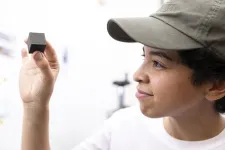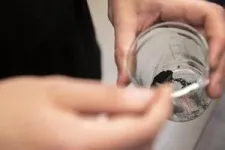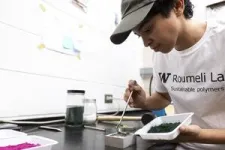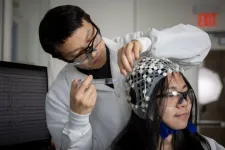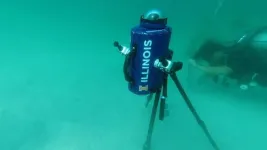(Press-News.org) We use plastics in almost every aspect of our lives. These materials are cheap to make and incredibly stable. The problem comes when we're done using something plastic — it can persist in the environment for years. Over time, plastic will break down into smaller fragments, called microplastics, that can pose significant environmental and health concerns.
The best-case solution would be to use bio-based plastics that biodegrade instead, but many of those bioplastics are not designed to degrade in backyard composting conditions. They must be processed in commercial composting facilities, which are not accessible in all regions of the country.
A team led by researchers at the University of Washington has developed new bioplastics that degrade on the same timescale as a banana peel in a backyard compost bin. These bioplastics are made entirely from powdered blue-green cyanobacteria cells, otherwise known as spirulina. The team used heat and pressure to form the spirulina powder into various shapes, the same processing technique used to create conventional plastics. The UW team's bioplastics have mechanical properties that are comparable to single-use, petroleum-derived plastics.
The team published these findings June 20 in Advanced Functional Materials.
"We were motivated to create bioplastics that are both bio-derived and biodegradable in our backyards, while also being processable, scalable and recyclable," said senior author Eleftheria Roumeli, UW assistant professor of materials science and engineering. "The bioplastics we have developed, using only spirulina, not only have a degradation profile similar to organic waste, but also are on average 10 times stronger and stiffer than previously reported spirulina bioplastics. These properties open up new possibilities for the practical application of spirulina-based plastics in various industries, including disposable food packaging or household plastics, such as bottles or trays."
The researchers opted to use spirulina to make their bioplastics for a few reasons. First of all, it can be cultivated on large scales because people already use it for various foods and cosmetics. Also, spirulina cells sequester carbon dioxide as they grow, making this biomass a carbon-neutral, or potentially carbon-negative, feedstock for plastics.
"Spirulina also has unique fire-resistant properties," said lead author Hareesh Iyer, a UW materials science and engineering doctoral student. "When exposed to fire, it instantly self-extinguishes, unlike many traditional plastics that either combust or melt. This fire-resistant characteristic makes spirulina-based plastics advantageous for applications where traditional plastics may not be suitable due to their flammability. One example could be plastic racks in data centers because the systems that are used to keep the servers cool can get very hot."
Creating plastic products often involves a process that uses heat and pressure to shape the plastic into a desired shape. The UW team took a similar approach with their bioplastics.
"This means that we would not have to redesign manufacturing lines from scratch if we wanted to use our materials at industrial scales," Roumeli said. "We've removed one of the common barriers between the lab and scaling up to meet industrial demand. For example, many bioplastics are made from molecules that are extracted from biomass, such as seaweed, and mixed with performance modifiers before being cast into films. This process requires the materials to be in the form of a solution prior to casting, and this is not scalable."
Other researchers have used spirulina to create bioplastics, but the UW researchers' bioplastics are much stronger and stiffer than previous attempts. The UW team optimized microstructure and bonding within these bioplastics by altering their processing conditions — such as temperature, pressure, and time in the extruder or hot-press — and studying the resulting materials' structural properties, including their strength, stiffness and toughness.
These bioplastics are not quite ready to be scaled up for industrial usage. For example, while these materials are strong, they are still fairly brittle. Another challenge is that they are sensitive to water.
"You wouldn’t want these materials to get rained on," Iyer said.
The team is addressing these issues and continuing to study the fundamental principles that dictate how these materials behave. The researchers hope to design for different situations, by creating an assortment of bioplastics. This would be similar to the variety of existing petroleum-based plastics.
The newly developed materials are also recyclable.
"Biodegradation is not our preferred end-of-life scenario," Roumeli said. "Our spirulina bioplastics are recyclable through mechanical recycling, which is very accessible. People don't often recycle plastics, however, so it's an added bonus that our bioplastics do degrade quickly in the environment."
Co-authors on this paper are UW materials science and engineering doctoral students Ian Campbell and Mallory Parker; Paul Grandgeorge, a UW postdoctoral scholar in materials science and engineering; Andrew Jimenez, who completed this work as a UW postdoctoral scholar in materials science and engineering and is now at Intel; Michael Holden, a UW master's student studying materials science and engineering; Mathangi Venkatesh, a UW undergraduate student studying chemical engineering; Marissa Nelsen, who completed this work as a UW undergraduate student studying biology; and Bichlien Nguyen, a principal researcher at Microsoft. This research was funded by Microsoft, Meta and the National Science Foundation.
###
For more information, contact Roumeli at eroumeli@uw.edu. Note: Roumeli is on Eastern Time this week.
END
URBANA, Ill. — For those whose primary experience with corn is the butter-drenched cob variety, it might come as a surprise that other forms of sweet corn are in trouble. A new University of Illinois Urbana-Champaign analysis shows sweet corn production for frozen and canned products has been steadily shrinking in the U.S. over the past 27 years, particularly in rainfed portions of the Midwest.
“The processing sweet corn industry [corn grown for canned and frozen products] was thriving in the U.S. throughout the 20th century. This type of production, ...
Antiracist Structural Intervention at the Emory University Institutional Review Board
Francois Rollin, Vanessa Van Doren, Jessica Alvarez, Rebecca Rousselle, Jada Bussey-Jones
Although racial and ethnic categories are social constructs without inherent biologic or genetic meaning, race and ethnicity impact health outcomes through racism. The use of racial categories in biomedical research often misattributes the cause of health inequities to genetic and inherent biological differences rather than to racism. Improving research ...
Philadelphia, July 10, 2023 – A long-standing and contentiously debated question is the extent to which US federal food assistance programs contribute to or deter healthy beverage intake. Findings of a new study in the Journal of Nutrition Education and Behavior, published by Elsevier, show that while beverage intake patterns rarely differed between mothers and young children who participated only in the Supplementation Nutrition Program for Women, Infants, and Children (WIC), only the Supplemental ...
JULY 10, 2023, NEW YORK – A Ludwig Cancer Research study has discovered that the presence of relatively high numbers of immune cells known as monocytes in tumors is linked to better outcomes in esophageal cancer patients treated with a combination of chemotherapy and immunotherapy, or immunochemotherapy. Esophageal cancer is the sixth leading cause of cancer mortality worldwide, and the incidence of esophageal adenocarcinoma has been climbing at a relatively swift clip over the past 40 years. Survival times for inoperable or metastatic forms of the cancer range from 6 to 12 months.
Led by Ludwig Oxford Director Xin Lu and ...
ITHACA, N.Y. -- Humans make lots of irrational decisions in predictable ways, but what if we’re all just doing our best within the limits of our abilities?
Researchers were able to simulate human behaviors using a probabilistic finite automaton, a well-known model of limited computational power. They programmed the automatons to compete against each other in a wildlife poaching game, as either a rhino poacher or a ranger trying to stop the poaching.
When the automatons could remember everything, they settled into an optimal game strategy. But when researchers limited their memories, they took some decision-making shortcuts – the same ...
COLUMBUS, Ohio – Major progress could be made in fighting the youth vaping epidemic with a complete restriction on sweet flavorings and cooling agents in both cartridge and disposable e-cigarette devices, according to a new study from the Center for Tobacco Research at The Ohio State University Comprehensive Cancer Center. The current U.S. Food and Drug Administration (FDA) flavor ban only applies to cartridge electronic cigarette devices.
A new study published in the Journal of Studies on Addiction and Drugs by researchers ...
July 10, 2023 — The Population Council’s GIRL Center, and co-hosts AFIDEP, AMPLIFY Girls, Baobab Research Programme Consortium, Children’s Investment Fund Foundation, Coalition for Adolescent Girls, Exemplars in Global Health, FP2030, Girl Effect, Girls First Fund, Conrad N. Hilton Foundation, the National Democratic Institute (NDI), Plan International, PMNCH, Purposeful, Together for Girls, UNICEF, Women Deliver, and The World Bank Africa Gender Innovation Lab, are proud to host the “Girls Deliver: Pre-Conference on Adolescent Girls,” on July 16. This one-day global convening ...
HOUSTON – (July 10, 2023) – One of the main ways cells “talk” to each other to coordinate essential biological activities such as muscle contraction, hormone release, neuronal firing, digestion and immune activation is through calcium signaling.
Rice University scientists have used light-activated molecular machines to trigger intercellular calcium wave signals, revealing a powerful new strategy for controlling cellular activity, according to a new study published in Nature Nanotechnology. This technology could lead to improved treatments ...
The study of biomarkers in the brain—powered by cutting-edge machine learning techniques—could redefine the way mental health conditions are categorized and diagnosed and lead to more effective, personalized treatments.
That’s the goal of Yu Zhang, an assistant professor of bioengineering and electrical and computer engineering in Lehigh University’s P.C. Rossin College of Engineering and Applied Science who recently landed major support from the National ...
University of Illinois Urbana-Champaign researchers have developed a novel method for underwater geolocalization using deep neural networks that have been trained on 10 million polarization-sensitive images collected from locations around the world. This new study, led by electrical and computer engineering professor Viktor Gruev, along with computer science professor David Forsyth, enables underwater geolocalization using only optical data while providing a tool for tethered-free underwater navigation.
These findings were recently published in the journal eLight.
“We are showing for the first time, you can geolocate yourself, or a camera, in a number of different ...
